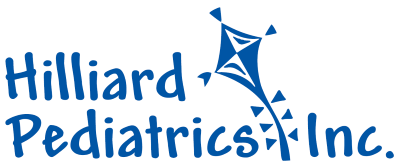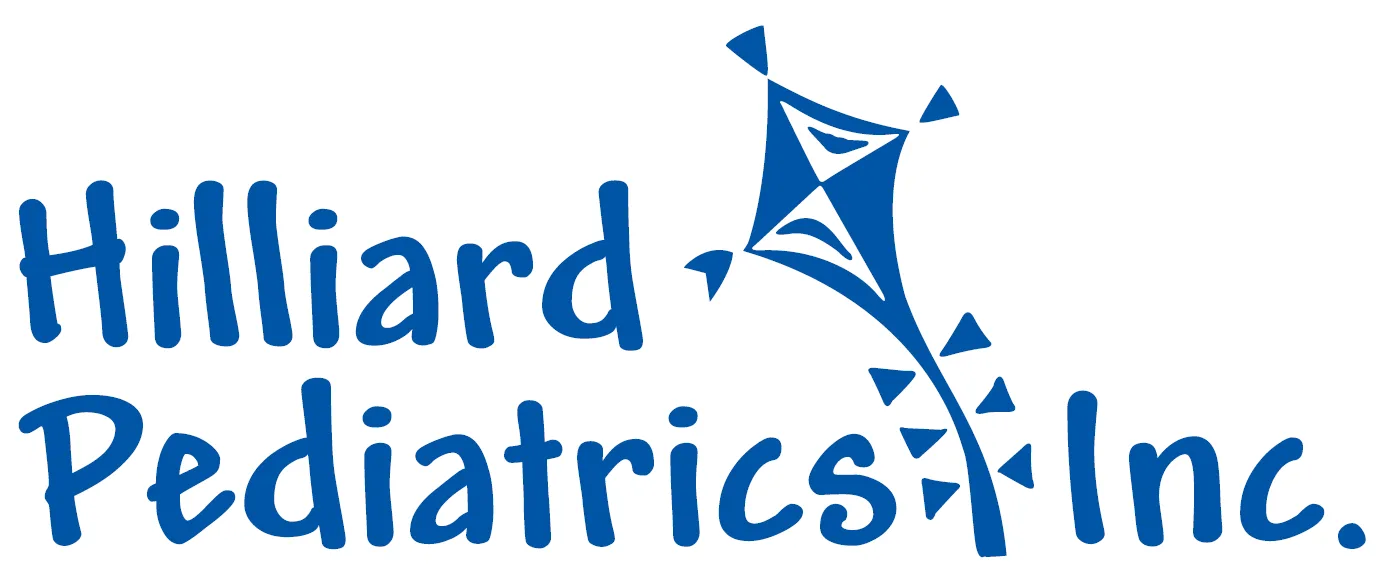Concussion
Hilliard Pediatrics, Inc. - Dr. Tricia Lucin, MD
Introduction
A concussion is a traumatic brain injury resulting from impact, collision, or jolting the head resulting in the brain moving rapidly back and forth within the skull. This sudden impact causes release of chemicals, damage to blood vessels, and stretching or damage to brain cells. Because of this, a person with a concussion might have a headache, fatigue, dizziness, cloudy thinking, and more. Concussions generally heal on their own but multiple concussions over time can be dangerous or deadly. Ohio has laws in place to help keep athletes safe when a concussion is suspected.
Please note, this is only a brief overview and cannot diagnose or treat your child. If you have concerns, please call us or seek medical treatment.
Any child who sustains a head impact and is suspected of having a concussion should be removed from play immediately and should not return to play the same day.
What causes concussions?
Concussions occur after a blow to the head, neck, or body with a jerk or rapid change in direction of the head. Interestingly, concussions can also happen without a direct blow to the head, if the brain goes through very fast direction changes, twists, or decelerations (think: car accident). Think of the yolk of an egg inside a shell. The brain (like the yolk) is floating in fluid inside the skull (like the eggshell), but a significant force can jostle the brain (yolk) against skull (shell). The blow to the head is not always witnessed and the impact itself might appear to be mild or severe. After the impact, chemicals are released from the damaged brain tissue and surrounding structures which causes the symptoms that follow. Blood supply can be temporarily decreased, and glucose (energy!) supply of the brain can be depleted, all causing the brain to work less efficiently than usual.
How common are concussions?
Well, we see concussions most in athletes playing contact sports, but we also see concussions in 4-year-olds who are going a little too fast and take a nose-dive into the coffee table. Because concussions don’t need specific testing or imaging (more on this below), exact numbers are hard to come by, but some estimates say that one in four to one in five people will experience a concussion by adulthood.
Signs and Symptoms:
After the impact, the person might appear dazed or dizzy. A person might pass out or lose consciousness briefly with a head injury of this type (but this is not required for a concussion to be present). The most common symptoms of concussion are:
- headache (the most common symptom!),
- visual changes
- dizziness and/or unsteadiness,
- nausea and/or vomiting,
- difficulty concentrating (including schoolwork),
- confusion and brief trouble remembering,
- emotional irritability or sadness,
- and drowsiness, trouble sleeping, or increased sleep need.
How is a concussion diagnosed?
Here’s the tricky part. There is no blood test, CT scan, or nasal swab that can diagnose a concussion (as of 2024!). Concussions are diagnosed based on the inciting event, observation of those around the person who sustained the injury (if present), and symptom report of the injured person. Especially in small children, parental reports are also valuable. CT scans are utilized to rule out more significant or severe injuries such as bleeding in the brain or spinal cord injuries. Typically, a person does not need head imaging if they had no loss of consciousness, normal mental status, no sign of skull fracture, and no vomiting.
There are many scales, symptom questionnaires and assessment tools which can be used to help delineate concussions both on the field and off the field. If pre-participation testing is available, comparison of the before and after is helpful but not necessary. All of these tests attempt to assess symptoms and signs which indicate brain dysfunction, including the symptoms listed above, as well as balance, reaction time, and thinking speed.
Because there is no specific test which is perfect at diagnosing concussions (and because so much relies on the HONEST reporting of the patient), doctors tend to make patients really prove they DON’T have symptoms before we will say there is not a concussion. Similarly, because such harm can come from a concussion that isn’t properly rested and treated (more to come on this), the medical community is very cautious to be sure we don’t miss concussions.
Who needs to go to the Emergency Room?
First, let me say, that if you are worried about your kid, you SHOULD seek medical care, and this cannot cover all the many reasons a child should be further evaluated. But for general purposes, a child should be seen in the urgent care or ER if the child passes out with injury or has a very severe headache or significant bruising to the eyes/face. Certainly, if the child had seizure-type movements or if they are acting strangely, not walking or talking correctly, or if they have repeated vomiting, they should be seen urgently. If the injury was sustained by significant force- car accident, a struck pedestrian, falls from a height greater than the child’s own height, or a head injury by a blunt force object (baseball bat, etc.), or any injury causing skull deformity should go to the ER via EMS and 911.
OK, I don't think we need the ER, so then what?
Well, keep a close eye on your kid. Symptoms can change, and you should act accordingly. But if the injury occurred a few hours ago and your child is acting fine, you are probably ok! Yes, your child might have a headache or feel dizzy. You can treat pain with acetaminophen (preferred over ibuprofen for this) cand you can let them rest. You do NOT need to wake your child overnight if you were able to observe them for some time before bed. Keep track of symptoms and certainly call us if you have questions.
How are concussions treated?
After medical evaluation determines that a patient has a concussion but no other worrisome problems, the treatment is, in essence, allowing the brain to rest and heal. Of paramount importance is avoiding repeat injury through removal from additional competition (in athletes) or decreasing risk of other activities.
Previously, complete rest was recommended (dark room, no screens, limited noise, etc.), but in recent years we have learned that RELATIVE rest is more conducive to healing. Note that the duration of rest needed will vary from patient to patient. Some kids feel 100% after 36 hours, and some are still having some level of symptoms after 2 weeks. Kids with significant symptoms past this point will likely need special follow-up in the concussion clinic.
Physical Recovery
A brief period of physical rest (24-48h) followed by gradual and progressive return to non-contact aerobic activities (not weightlifting or jumping) is typically standard care. If symptoms are worsened by light physical activity, then this should be stopped and retried the following day. Early LIMITED aerobic activities can help with faster recovery from concussion while preventing deconditioning. Initial activities should be walking or stretching, but nothing that results in heavy breathing. Avoidance of any activities that could cause contact to the head or jolting of the body is necessary. Return to play progression (to follow) will follow these baseline low-output activities when symptoms are fully resolved.
Cognitive Recovery
A brief rest (24-48h) from cognitive efforts (school) might be warranted, but many patients can return to school the day following concussions. If symptoms are worsened by school, tablets, video games or reading, then these should be avoided and retried the next day. School should be facilitated with accommodations as needed to allow students to return as early as possible, with rest breaks as needed. Sometimes half days are needed to control symptoms, and screen rest should be encouraged. Video games, loud music, and high levels of concentration frequently induce or worsen symptoms.
Headaches can be treated with acetaminophen or ibuprofen, although frequent headaches can be a marker of overexertion. If headaches need medication after a few days post injury, a visit to the office is likely warranted.
Similarly, for worsening symptoms despite appropriate rest and low levels of activity, an office visit should be considered.
Return to Play Progression
Per the Ohio concussion law, patients may START the return to play protocol when they are symptom-free and back to baseline, off of all headache meds, and in school full days without increasing symptoms. The Ohio law states that a medical provider must clear an athlete for return to play in organized sports. Each step will take at least 24 hours, and the patient should have NO return of symptoms prior to advancing to the next step. Many patients will need more than 24 hours on each step.
- Step 1: Light aerobic activity (hopefully already has been happening early in recovery)
- Walk, stationary bike, etc for 20-30 minutes
- Step 2: Moderate aerobic exercise
- Jogging, moderate stationary bike, and sports specific drills without contact for 30-40 minutes
- Step 3: Heavy non-contact physical activity
- Sprinting, resistance machines or free weights, jumping for 45-60 minutes
- Step 4: Full-contact practice or scrimmage
- Step 5: Full-contact play
Who needs and office visit after a concussion?
Well, we are happy to check out any kid after a head injury. But if your child meets the low-risk points above, it is also ok to follow the rest protocol as described. Every athlete needs to be cleared by a medical provider PRIOR to starting the return to play protocol, meaning, before doing anything more than just light movement.
Nationwide Children’s also has a concussion clinic (as do some local physical therapy offices) which can help if symptoms last longer than 2 weeks, are unusually severe, or if they do not follow normal concussion patterns.
What to do when:
- My child hit their head during play:
- First, stay calm! You staying calm helps them to do the same. Assess their injury severity and how they are behaving. Grab an ice pack if they are acting ok but need some reassurance. Watch for the signs and symptoms described above
- My child got hit by something very hard and/or passed out with injury:
- Probably your child needs to be seen in the urgent care or emergency room.
- My child has a goose egg on their head but is acting ok and didn’t pass out:
- Grab an ice pack. Feel that head and make sure there is nothing squishy or abnormal other than the goose egg. Keep a close eye- often these will go down fairly quickly with an ice pack. If it doesn’t and/or you aren’t sure about how the head feels under the swelling, get to the urgent care or call our office for a same-day visit.
- My child hit their head and is acting wacky, passed out for longer than a few seconds, had a seizure, has “raccoon eyes”, or is vomiting repeatedly:
- Call 911 for transport to the nearest hospital
- https://www.cdc.gov/heads-up/
- http://www.nationwidechildrens.org/concussion-law
- https://odh.ohio.gov/know-our-programs/child-injury-Prevention/youthconcussions
Last Updated: 09/2024

